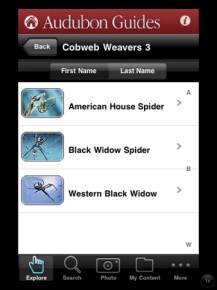 Those of you that know me, know that I’m a passionate entomologist. I’m currently in school, seeking my degree in the subject, with the final goal of a PhD. It’s safe to say, I know my bugs. Not only do I know my bugs, I’m a bit of an expert on spiders, with fifteen years of experience working with them on a semi-professional level.
Those of you that know me, know that I’m a passionate entomologist. I’m currently in school, seeking my degree in the subject, with the final goal of a PhD. It’s safe to say, I know my bugs. Not only do I know my bugs, I’m a bit of an expert on spiders, with fifteen years of experience working with them on a semi-professional level.
Now that my credentials are out of the way, I can tell you about the Audubon’s Field Guide to North American Insects and Spiders app for the iPhone and iPod Touch. Needless to say, I was elated to get this app to review, as it was one I’ve been wanting to try for myself for some time. While I know my spiders inside-and-out, I still need to look up other inverts I stumble across. The ability to access a guide like this on my iPhone, which I already have for its GPS abilities when I’m out hiking (check out Easy Trails GPS 4), is a great convience over carrying a book around.
I want to note with this app does not include moths and butterflies. The reason for this is that Audubon has always had a separate guide for them since they’re the most popular type of bug. It’s always the pretty ones that are famous, right? I had no problem with that. I already have an app specifically for those types of insects (Butterflies & Moths of North America). So if you’re looking for a guide for Lepidoptera, this isn’t it.
 The first thing I did to check the usefulness of this app was to look at the spiders. I immediately went to my personal favorite, the jumping spiders. Audubons’s guide app only lists one. That’s right: One! If we even want to limit this to just the US, there are over 800 species here, alone. This didn’t bode well. How about tarantulas then? There are three listed, and one is a doubled entry. There are thousands of species of tarantulas worldwide! Okay, so the guide claims to cover just “North America”, well there are still 30 species of tarantulas in the US alone. Next I went to an area I have a very good understand of…Roaches. The guide lists two different families of roaches, but only one species in each. I’ve seen more species in a single infested home! While these are some of the worst cases, there really is an extreme lack of variety in every family available inside the app.
The first thing I did to check the usefulness of this app was to look at the spiders. I immediately went to my personal favorite, the jumping spiders. Audubons’s guide app only lists one. That’s right: One! If we even want to limit this to just the US, there are over 800 species here, alone. This didn’t bode well. How about tarantulas then? There are three listed, and one is a doubled entry. There are thousands of species of tarantulas worldwide! Okay, so the guide claims to cover just “North America”, well there are still 30 species of tarantulas in the US alone. Next I went to an area I have a very good understand of…Roaches. The guide lists two different families of roaches, but only one species in each. I’ve seen more species in a single infested home! While these are some of the worst cases, there really is an extreme lack of variety in every family available inside the app.
For each species, you’ll get a few basic tidbits about the bug in question: a very high quality image, the scientific and common name, and some basic information on it. You also have the ability to post a sighting with GPS coordinates, but you have to register for an account to do so. Even with this feature, there is no way to see a map with their geographical locations highlighted. Sadly, this is one of the most important things needed in a solid identification.
In Conclusion
Much to my dismay, this Audubon Field Guide to North American Insects and Spiders is not something I’m keeping on my iPhone. It’s just not useful to me in the least. I can only see this being pertinent to curious children or very casual bug lovers. At $10, it’s extremely devoid of features that justify the price. To be honest, I’m going to stick with my printed bug manual until something better is released or this app gets a MAJOR overhaul.


















